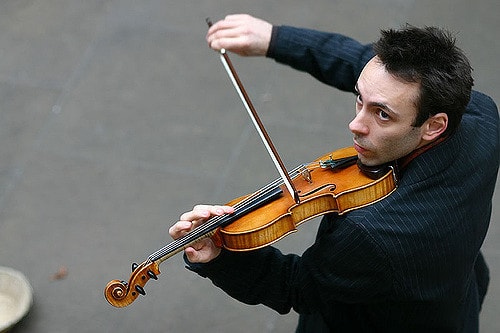Like any other instrument, playing the violin requires skill and determination. You will need to always be on the lookout for some of the things you can do to make your violin playing interesting and appealing. Being a pro-active learner will help you get acquainted with the various violin-playing tricks and techniques that set apart the learner from the expert.
Setting goals will focus your energies so that you are not here and there on your violin learning journey. Carrying out research on different violin techniques and asking your teacher for clarification as you go along will also keep you from getting discouraged. You can then purpose to master them one at a time as you proceed.

In this article, we shall explore three of these techniques which you can start working on. They are as follows:
- Right Hand Finger Action
Are there theories you have heard about how the right-hand fingers should or shouldn’t hold the bow? Well, this is a common debate among violin players, and since it has a lot to do with how the bow is held, you definitely need to get rid of any wrong ideas that you may have. The following article dispels some of the common myths that have been doing their round in the violinists’ world:
Right hand finger action is a cause for bewilderment by many students. The myth is that the fingers must be trained to move back and forth, to curl and straighten, to effect a proper bow hold. While in principal its true these movements need to occur, the movements are the effect of a chain of events in the bow arm and not the cause of those movements in such bow strokes as spiccato and of course detache & legato.
To achieve this, Valborg Leland, who was a disciple of pioneering teacher D.C. Dounis explains one must find the *’naturally inclined position’ with respect to the fingers and wrist of the right hand. Once this is achieve the player can develop a feeling of ease in the right hand as fingers can begin to react to the arm weight. Via Rozanna Violins
- Great Bow arm movement

Image Courtesy of Flickr
In violin playing, the bow is what creates the sound. The bow arm has two basic movements: moving the bow vertically between strings, and moving the bow horizontally across strings. In order to achieve a beautiful tone, these movements must be understood and continually practiced. Below are some tips and tricks to help you develop a stronger bow arm.
Vertical Movement Between Strings
Due to the curved shape of the bridge, the four strings on the violin are in the shape of an arc with G at one end and E at the other. In order to get the bow to come in contact with all four strings, the bow arm moves higher and lower, with the movement originating from the shoulder. The arm is held highest when playing on the G string, and lowest when playing on the E string. Via TakeLessons
Basically, mastering the movements of the bow arm will make a huge difference to the sound produced when playing the violin. As the above post explains, you will also need to pay attention to your wrists and elbows and make sure they are in the correct position. As you continue working on the skill, your body will naturally take the desired shape as it becomes less strenuous for you.
- All About the Scales
How have you been going about playing the scales on your violin? Have you been using them as warm-up routines? And what do you do so that you ensure that you get things right? Below is a collection of advice from violin instructors that will help you master this aspect of violin playing that improves your technique:

Scales improve technique, but not just by paying them lip service. Simply playing through a couple of scales during a practice session will have very little impact on a pupil’s technical development. ‘Slim-o-Food will only help you lose weight as part of a calorie-controlled diet’, the ads tell us. Similarly, scales will only affect technique if they are part of a holistic approach to teaching. Time and concern must simultaneously be put into posture, arm positions, precision of finger movement and positioning. In addition, it is essential that the many connections with aural work are brought to the fore.
Paul Harris, The Strad, November 2001 Via The Strad
According to Paul Harris in the post above, you cannot just play the scales just to get through them and expect to get really good at the skill. Since it is part of the bigger picture and a fundamental one at that, you need to ensure you are at your best in scales. Everything else you will play on your instrument will be greatly determined by how well you go about them. The other instructors in the post give more advice on how to master the scales.
Now you can get going on mastering these techniques and become the great violinist you’ve always hoped to be!
Featured Image: Image Credit
Please enjoy the national anthem, as played on a 300-year-old violin: https://t.co/vcJSYfFjcS pic.twitter.com/z7aDLSElAJ
— Cut4 (@Cut4) August 23, 2016
Would anyone else be happy if SummerSlam were just three hours of Nakamura’s violin-accompanied entrance?
— Kayfabe News (@KayfabeNews) August 22, 2016
Related Articles:
5 Violin Techniques Every Beginner Should Master
Congratulations! You’ve been introduced to the wonderful art of music through one of the most beautiful instruments, the violin. As you continue to discover this wonderful instrument, it’s important to slowly build your skill set.
After all, learning to play the violin can be intimidating at first, and you don’t want to get overwhelmed by learning too much too fast. Below are five basic violin techniques every beginner should master before moving onto more complex techniques.
Double Stops
The string family can do something that not many other instruments can: play two notes at the same time. Composers take advantage of this special quality very often, which is why it’s so important that you work on it from the early stages of your musical development. Via TakeLessons
An introduction to violin/viola left hand technique
Welcome to my new series of tutorials for composers, arrangers and anyone else who may need to write for strings, whether it’s a full orchestral film score, or a string quartet for a singer song writer. Here I will share some of the knowledge that has helped me both as a composer and arranger myself, but also as a professional orchestral player and lastly some of the techniques I rely on everyday when I write and record strings for people around the world. I plan to not only cover how the string instruments are played and what that means for writing idiomatic phrases that feels natural to the players while serving your musical intention, but also production techniques, how to get a good sounding recording, mic placement, mixing and so on. Via The Steely Dane Strings
Violin Techniques: How to Use the Bow
Holding a violin correctly is important, but knowing how to hold and use a bow is essential to a great sound. There are a few techniques you need to know to make sure you’re using the bow correctly. In this guide, you’ll learn how a bow works, and how to hold and use it.
Bow Basics
There is graceful flexibility in every stroke of the bow. The bow moves across the string by bending your fingers, wrist, arm, and shoulders in a related set of motions. This cooperation of the various parts of your arm allows a smooth and straight bowing motion. Let’s try it! Via Idiots Guides

